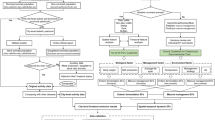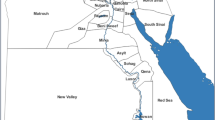Abstract
The mitigation of methane (CH4) emissions from livestock production is crucial to China’s carbon neutrality. Here we established a high-spatiotemporal-resolution dataset of the country’s livestock CH4 emissions from 1990 to 2020 using four large-scale national livestock greenhouse gas inventory surveys. We estimate CH4 emissions to be 14.1 ± 2.0 Mt in 2020 and to increase by 13% until 2030 despite CH4 intensity per kg animal protein having decreased by 55% in the past 30 years. Approximately half of the emissions come from 13% of all Chinese counties. The technical CH4 mitigation potential is projected to be 36 ± 8% (4.4–6.9 Mt CH4) in 2030, and reducing food loss and waste could mitigate an additional 1.6 Mt of CH4. Overall, most CH4 mitigation could be achieved by increasing animal productivity and coverage of lagoon storage at carbon prices below US$100 tCO2e−1, being more cost-effective than livestock nitrous oxide mitigation in China.





Similar content being viewed by others
Data availability
The data used to calculate the livestock CH4 emission factor in this paper are available in Supplementary Information, sourcing from the four national livestock greenhouse gas inventory surveys. The historical animal activity data are from published yearbooks, such as the China Agriculture Yearbook, China Animal Husbandry and Veterinary Yearbook and Animal Husbandry Statistics of China. The data from the second China livestock pollution source census are from a non-public database, and these data are available upon request to the corresponding authors. The CH4 emission, animal performance, and import and export data of livestock products from other countries were derived from the FAOSTAT database (http://www.fao.org/faostat/#en/#dat). The basemaps are from National Catalogue Service or Geographic Information (http://www.webmap.cn/). The cost–benefit information is from the published China Agricultural Products Cost–Benefit Yearbook (2021). Correspondence and requests for materials should be addressed to H.D. Source data are provided with this paper.
Code availability
Microsoft Excel 2021 was used to handle and structure input data. The spatial analysis was conducted using ArcGIS version 10.2. All code is available upon request.
References
Jackson, R. B. et al. Increasing anthropogenic methane emissions arise equally from agricultural and fossil fuel sources. Environ. Res. Lett. 15, 071002 (2020).
Höglund-Isaksson, L. et al. Technical potentials and costs for reducing global anthropogenic methane emissions in the 2050 timeframe—results from the GAINS model. Environ. Res. Commun. 2, 025004 (2020).
FAO FAOSTAT http://faostat.fao.org/ (FAO, 2022)
UNFCCC National Inventory Submissions 2021 https://unfccc.int/ghg-inventories-annex-i-parties/2021 (UNFCCC, 2021).
EDGAR Emissions Database for Global Atmospheric Research v.5.0 https://edgar.jrc.ec.europa.eu/overview.php?v=50_AP (European Commission, 2019).
Ministry of Ecology and Environment of the People’s Republic of China The People’s Republic of China Second Biennial Update Report on Climate Change (MEE, 2018).
EPA Global Non-CO2 Greenhouse Gas Emission Projections & Mitigation Potential: 2015–2050 https://www.epa.gov/global-mitigation-non-co2-greenhouse-gases/global-non-co2-greenhouse-gas-emission-projections (EPA, 2019).
Xu, P. et al. Policy-enabled stabilization of nitrous oxide emissions from livestock production in China over 1978–2017. Nat. Food 3, 356–366 (2022).
Editorial Committee of China Agricultural Yearbook China Agriculture Yearbook (1991–2021) (China Agriculture Press, 2021).
Editorial Committee of Chinese Animal Husbandry and Veterinary Yearbook China Animal Husbandry and Veterinary Yearbook (1999–2021) (China Agriculture Press, 2021).
Zhu, Z. et al. Integrated livestock sector nitrogen pollution abatement measures could generate net benefits for human and ecosystem health in China. Nat. Food 3, 161–168 (2022).
Xu, P. et al. Northward shift of historical methane emission hotspots from the livestock sector in China and assessment of potential mitigation options. Agric. For. Meteorol. 272, 1–11 (2019).
Bai, Z. et al. China’s pig relocation in balance. Nat. Sustain. 2, 888 (2019).
MOA The 11th Five-Year Plan for the National Protection and Construction Programme of Grasslands http://www.moa.gov.cn/nybgb/2006/dseq/201806/t20180616_6152372.htm (Ministry of Agriculture of China, 2006).
The 14th Five-Year Plan for the Development of the National Animal Husbandry and Veterinary Industry https://www.gov.cn/zhengce/zhengceku/2021-12/22/content_5663947.htm (Ministry of Agriculture and Rural Affairs of the People’s Republic of China, 2021).
Zhang, X. et al. Societal benefits of halving agricultural ammonia emissions in China far exceed the abatement costs. Nat. Commun. 11, 4537 (2020).
Tong, B. et al. Lower pork consumption and technological change in feed production can reduce the pork supply chain environmental footprint in China. Nat. Food 4, 74–83 (2023).
Li, S. et al. Report on technological development of dairy industry in 2021 [in Chinese with an English abstract]. Chin. J. Anim. Sci. 58, 239–244 (2022).
IPCC Climate Change 2013: The Physical Science Basis (eds Stocker, T. F. et al.) (Cambridge Univ. Press, 2013).
Cao, B. H. et al. Report on technical development of beef and yak industry in 2021 [in Chinese with an English abstract]. Chin. J. Anim. Sci. 58, 245–250 (2022).
National Development and Reform Commission of the People’s Republic of China China Agricultural Products Cost–Benefit Yearbook 2021 (China Statistics Press, 2021).
Arndt, C. et al. Full adoption of the most effective strategies to mitigate methane emissions by ruminants can help meet the 1.5 °C target by 2030 but not 2050. Proc. Natl Acad. Sci. USA 119, e2111294119 (2022).
Wang, Y. et al. Mitigating greenhouse gas and ammonia emissions from beef cattle feedlot production—a system meta-analysis. Environ. Sci. Technol. 52, 11232–11242 (2018).
Hegarty, R. S. et al. An Evaluation of Emerging Feed Additives to Reduce Methane Emissions from Livestock (CCAFS, NZAGRC, GRA, 2021).
Ao, R.A.L. The Potential of Feeding Nitrate to Reduce Enteric Methane Production in Ruminants. Report to the Department of Climate Change, Canberra, Australia (Commonwealth Government of Australia, 2008).
Wang, Y. et al. Mitigating greenhouse gas and ammonia emissions from swine manure management: a system analysis. Environ. Sci. Technol. 51, 4503–4511 (2017).
Opinions of the Central Committee of the Communist Party of China and the State Council on Deepening the Fight Against Pollution https://www.gov.cn/zhengce/2021-11/07/content_5649656.htm (China State Council, 2021).
Li, B. et al. Responses of soil organic carbon stock to animal manure application: a new global synthesis integrating the impacts of agricultural managements and environmental conditions. Glob. Chang. Biol. 27, 5356–5367 (2021).
Wang, B. et al. Four pathways towards carbon neutrality by controlling net greenhouse gas emissions in Chinese cropland. Resour. Conserv. Recycl. 186, 106576 (2022).
Zhang, X. et al. Benefits and trade‐offs of replacing synthetic fertilizers by animal manures in crop production in China: a meta‐analysis. Glob. Chang. Biol. 26, 888–900 (2020).
Xue, L. et al. China’s food loss and waste embodies increasing environmental impacts. Nat. Food 2, 519–528 (2021).
IPCC 2006 IPCC Guidelines for National Greenhouse Gas Inventories Vol. 4: Agriculture, Forestry and Other Land Use. Ch. 10 Emissions from Livestock and Manure Management (IPCC, 2016).
Department of Animal Husbandry, Ministry of Agriculture and Rural Affairs of China and National Animal Husbandry Service Animal Husbandry Statistics of China (China Agriculture Press, 2021).
Gerber, P. J. et al. Tackling Climate Change Through Livestock—A Global Assessment of Emissions and Mitigation Opportunities (FAO, 2013).
Du, Y. et al. A global strategy to mitigate the environmental impact of China’s ruminant consumption boom. Nat. Commun. 9, 4133 (2018).
Eshel, G. et al. Land, irrigation water, greenhouse gas, and reactive nitrogen burdens of meat, eggs, and dairy production in the United States. Proc. Natl Acad. Sci. USA 111, 11996–12001 (2014).
Bai, Z. et al. China’s livestock transition: driving forces, impacts, and consequences. Sci. Adv. 4, eaar8534 (2018).
Market Early Warning Expert Committee of the Ministry of Agriculture and Rural Affairs China Agricultural Outlook 2021–2030 (China Agricultural Science and Technology Press, 2021).
Klimont, Z. et al. Integrated Ammonia Abatement—Modelling of Emission Control Potentials and Costs in GAINS (IIASA, 2011).
IPCC 2006 IPCC Guidelines for National Greenhouse Gas Inventories Vol. 1: General Guidance and Reporting. Ch. 3 Uncertainties (IPCC, 2006).
Dong, H. et al. Guidance for Measurement, Reporting and Verification of Livestock Greenhouse Gas Emissions (China Science Press, 2022).
Acknowledgements
H.D. acknowledged funding from the National Science Foundation of China (NSFC; grant number 32361143865) and the China Agriculture Research System of MOF and MARA (CARS-35-10B). B.G. acknowledged funding from the NSFC (grant numbers 42325707 and 42261144001). Y.W. acknowledged funding from the National Key Research and Development Project of China (2022YFE0138200).
Author information
Authors and Affiliations
Contributions
Y.W., H.D. and B.G. designed the study. H.D. and Z.Z. provided the national survey data. Y.W. performed the research. Y.W., X.Z., S.W. and B.G. analysed the economic data. Z.Z. prepared the distribution maps. H.D. and B.G. helped to interpret the results. Y.W. wrote the paper, B.G. and H.D. revised the paper and all other authors contributed to the discussion of the paper.
Corresponding authors
Ethics declarations
Competing interests
The authors declare no competing interests.
Peer review
Peer review information
Nature Food thanks Xiangwen Fan, Xuejun Liu and the other, anonymous, reviewer(s) for their contribution to the peer review of this work.
Additional information
Publisher’s note Springer Nature remains neutral with regard to jurisdictional claims in published maps and institutional affiliations.
Extended data
Extended Data Fig. 1 CH4 emissions induced by the China’s imported livestock product.
a, The embedded emissions in 2020. b, The embedded emissions in 2030.
Extended Data Fig. 2 Cumulative Chinese livestock CH4 emissions.
a, Cumulative probability of Chinese livestock CH4 emissions from each county. b, Cumulative probability of Chinese livestock CH4 emissions on aera basis.
Extended Data Fig. 3 Unit-based mapping of the major animal CH4 emissions.
Basemap from the National Catalogue Service for Geographic Information (http://www.webmap.cn/).
Extended Data Fig. 4 Historical change of CH4 emission intensity of the major four types of Chinese livestock product from 1990–2020.
a-d, Beef (a), mutton (b), dairy milk (c), and pork (d). The explanations for the fluctuations were explained in Supplementary Text 6.
Extended Data Fig. 5 Animal protein constitution.
a, Changes in the relative contributions of the major animal product to national produced animal sourcing protein in China for the period 1990–2020. b, Comparison of the constitutions of the animal produced protein in different regions.
Extended Data Fig. 6 Animal productivity deficit among the top 10 animal CH4 emitting nations.
a–d, beef productivity (a), dairy milk productivity (b), mutton productivity (c), and pork productivity (d). The data are compiled from literature survey (China Animal Husbandry and Veterinary Yearbook10, China Agriculture Research System report18,20, and China Agricultural Products Cost-Benefit Yearbook21, FAOSTAT database3). US, BZ, EU, AU, MX, AG, PK, ET, IN, CN means USA, Brazil, the Europe Union, Australia, Mexico, Argentina, Pakistan, Ethiopia, India, China, respectively.
Extended Data Fig. 7 Unit-based mapping of the livestock CH4 emissions.
a, manure CH4 emissions. b, enteric CH4 emissions. Basemaps from the National Catalogue Service for Geographic Information (http://www.webmap.cn/).
Extended Data Fig. 8 Comparison of the per capital consumption of the major ruminant product in different regions.
a–c, beef consumption (a), milk consumption (b), and mutton consumption (c).
Extended Data Fig. 10 Locations of the investigated counties in the four national scale animal GHG inventory surveys.
Basemap from the National Catalogue Service for Geographic Information (http://www.webmap.cn/).
Supplementary information
Supplementary Information
Supplementary Texts 1–6, Tables 1–22 and Figs. 1–5.
Source data
Source Data Fig. 1
Statistical source data.
Source Data Fig. 2
Statistical source data.
Source Data Fig. 3
Statistical source data.
Source Data Fig. 4
Statistical source data.
Source Data Fig. 5
Statistical source data.
Source Data Extended Data Fig. 1
Statistical source data.
Source Data Extended Data Fig. 2
Statistical source data.
Source Data Extended Data Fig. 3
Statistical source data.
Source Data Extended Data Fig. 4
Statistical source data.
Source Data Extended Data Fig. 5
Statistical source data.
Source Data Extended Data Fig. 6
Statistical source data.
Source Data Extended Data Fig. 7
Statistical source data.
Source Data Extended Data Fig. 8
Statistical source data.
Source Data Extended Data Fig. 10
Statistical source data.
Rights and permissions
Springer Nature or its licensor (e.g. a society or other partner) holds exclusive rights to this article under a publishing agreement with the author(s) or other rightsholder(s); author self-archiving of the accepted manuscript version of this article is solely governed by the terms of such publishing agreement and applicable law.
About this article
Cite this article
Wang, Y., Zhu, Z., Dong, H. et al. Mitigation potential of methane emissions in China’s livestock sector can reach one-third by 2030 at low cost. Nat Food 5, 603–614 (2024). https://doi.org/10.1038/s43016-024-01010-0
Received:
Accepted:
Published:
Issue Date:
DOI: https://doi.org/10.1038/s43016-024-01010-0
- Springer Nature Limited





